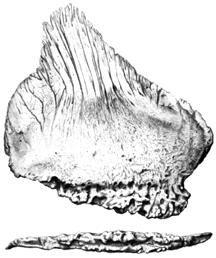One of the main goals of Americanist archaeology is to elucidate the cultural history of North America. Perhaps, the biggest problem concerns how and when North America was first settled. Recent finds at the Topper site in North Carolina may provide an answer to the when. Before I can discuss that, however, a little background is necessary. The following account is drawn from Gordon Willey's excellent "Introduction to American Archaeology Volume One: North and Middle America (1966).
The Climatic Background
The Pleistocene, in North America, is divided into four glacial and interglacial periods. The periods of glacial advance and retreat (called interstadials) are presented for the last (Wisconsin) stage below (these are for the Laurentide ice sheet, which covered eastern North American).
Glacial stages


Three other periods need to be mentioned. The Anathermal climatic stage occured from 8,000 to about 5,00 BC. During the Anathermal a minor glacial advance called the Cochrane advance occured. The Anathermal was followed by a period of warmer climates called the Altithermal. This is followed by the Medithermal - or period of climatic optimum, which lasted from around 5,000 to 2,500 BC. The medithermal was characterized by a climate much like that which we experience now.
Climate


It is within this context that most of the discussion of the "how" and "when" of North American Settlement takes place. There is abundant amount of evidence to indicate that the first immigrants to America came via the Bearing Land Bridge (so I won't discuss it). The problem has always been with the timing. There are only certain periods during which routes from Siberia to North America were passable. The main timeframe was 10,000-12,000 years ago and it had always been assumed that this was the time during which North America was settled. The first inhabitants of North America participated in a cultural tradition called the Big Game Hunting Tradition. The Big Game Hunting Tradition was adapted to and developed in a grasslands environment and most of the significant sites are found on the North American Plains. The Big Game Hunting Tradition, was, largely centered around the hunting of large mammals such as mammoth and buffalo. It is characterized by bifacially flaked fluted projectile points (such as Clovis - pictured below - Fulsom, Sandia and Plano) which date to around 10,000-9,000 years BC (or during the Two Creeks Interstadial which preceeded the Valders advance). Associated with the projectile points were a series of specialized and unspecialized choppers, scrappers, knives and drills.
clovis


clovis and beyond


However, there are a number of sites that may, or may not be older and which may or may not have earlier, more primitive technology. Such sites are found in both North and South America. They are characterized by crude, percussion flaked tools. Mainly scrapers, flakes and pebble choppers. They are also characterized by the absence of bifacially flked projectile points (such as Clovis). They are usually found in geological associations (or with faunal associations) that imply great age - if accepted.
For example, a site was found in Lewisville, Texas which consisted of pebble-choppers, hammerstones and flakescrapers in association with what were believed to be hearths. Radiocarbon dating of the hearths yielded dates of around 38,000 years old. There are several problems with the site however. First, it is entirely possible that the hearths were in fact not hearths. Rather the blackened areas excavators identified as hearths could actually be the results of burned vegetation (through lightening strikes, etc.). Second, the site was excavated through the use of heavy earth moving equipment and suffered some post-depositional mixing. A, possibly, intrusive Clovis point was found at the site.
Another interesting site is at Tule Springs, Nevada. The site was discovered in an erosion channel, later dated to 28,000-23,500 BC. It appeared to be a camp on the edge of an ancient lake. Remains of camel, bison, horse, mammoth and groundsloth were found near what seemed to be a fire area or charcoal lense. A number of scrapes and flakes as well as two bone implemets were also found. The entire site was covered with several feet of lake deposited clay and silt interbedded with fine sand and gravel. Unfortunately, later research indicated the site dated to approximately 11,000 BC.
These two sites are typical of pre-Clovis archaeology. There are a number of sites in both North and South America that contain - in the words of Gordon Willey - "...chipped stone complexes whose typology and isolation from technologically more advanced implements suggests the possibility of great age (Willey, see above pg 33)". These complexes have been christened the Pre-Projectile Point Horizon.
There are two possibilities, then, for the development of the Big Game Hunting Tradition.
First, people arrived in America much earlier than 10,000-12,000 years ago. They carried with them a tool kit reminiscent of the Southeast Asian Chopper-Chopping Tool tradition (characteized by rough core tools, chopppers and scrappers and the lack of bifaceial blades and points). Which would explain the tantilizing sights such as Lewisville and Tule Springs. This tradition eventually evolved into the Big Game Hunting Tradition. In this view, Clovis was an in situ development and humans arrived in North America considerably earlier.
Second, Clovis and related points evolved out of Asiatic and Eurasiatic prototypes - in particular complexes in western and southwestern Siberia. Some of these prototypes were related to Mousterian, Solutrean and Magdalenian antecedents. Ust'Kanskaia in western Siberia is a good example. The site is found in a cave in the Altai Mountains. Tools found at the site (bifaces, scrappers, burins, retouched flake points) reflect the Mousterian Tradition. It is argued that assmblages such as this blended, further east, with the Southeast Asian Chopper-Chopping Tool Tradition and were then carried into the new world. Interestingly enough, sites in Alaska and the Yukon share some of the same Mousterian flaking techiques as at, say Ust'Kanskaia.
In order to resolve which of these is correct, either of two things are needed. First, indiputable associations of pre-Clovis artifacts with middle or early Pleistocen deposits and convincing radiocarbon dates. Second, a complex of materials attributable to pre-Clovis assmblages are found stratigraphically beneath artifacts of the well known clovis tradition.


In 2004 Albert Goodyear found material he claims will satisfy on or possibly both of the above conditions. The Topper site, located on the banks of the Savannah River in South Carolina, is dated to 16,000-20,000 years ago and may be as old as 50,000 years (I am skeptical of this latter date as it pushes things to close to the neanderthals and early modern humans - remember neanderthals are found as late as 35,000 years ago in Europe). The picture above is of the stratigraphy of the site. The artifacts were found in the layer labeled Pleistocene Terrace. The artifacts themselves were a mixture of primitive scappers, flakes and points and they were found below Clovis. They were also found in association with a blackened area believed to be a hearth.
From the
Press Release: “The dates could actually be older,” Goodyear says. “Fifty-thousand should be a minimum age since there may be little detectable activity left.”
The dawn of modern homo sapiens occurred in Africa between 60,000 and 80,000 years ago. Evidence of modern man’s migration out of the African continent has been documented in Australia and Central Asia at 50,000 years and in Europe at 40,000 years. The fact that humans could have been in North America at or near the same time is expected to spark debate among archaeologists worldwide, raising new questions on the origin and migration of the human species.
Which would satisfy the second condition also. There are two problems. First, are the artifacts really human made tools or are they just rocks that look like they might be something? The Jury is out. Second concerns the date and the association with the hearth.
preclovis chert tools


It would be nice if we had a reliable way of determining whether any given hunk of rock is human made or not. There are several techniques such as trace wear analysis that do help. It gets difficult the closer you get to the origination of stone tools and there comes a point where the boundry is pretty muddled.
the dig


At any rate, I would be skeptical of the 50,000 year old date and certainly question dates older than that. I do, however, think that the 16,000 to 20,000 date (mentioned in the May National Geographic) is probably correct. I have always been somewhat skeptical of the notion that humans have only been in America for 10,000-12,000 years. The Pre-Projectile Point Horizon is a real phenomena - there are too many sites with this type of material to dismiss. Consequently, an explantion is needed and the best, to date, is that humans did indeed arive earlier than currently believed. Of course more proof is needed and Topper, like the other sites, is a tantilizing piece of the puzzle.



























 Be afraid, we are wild, ferocious, jungle kitties
Be afraid, we are wild, ferocious, jungle kitties






